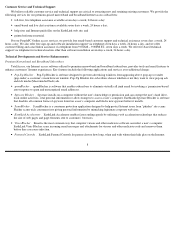Earthlink 2005 Annual Report Download - page 19
Download and view the complete annual report
Please find page 19 of the 2005 Earthlink annual report below. You can navigate through the pages in the report by either clicking on the pages listed below, or by using the keyword search tool below to find specific information within the annual report.
Competitive product, price or marketing pressures could cause us to lose existing customers to competitors (churn), or may cause us to
reduce prices for our services which could adversely impact average revenue per user.
Competition impacts our ability to price our services and retain customers. As the market for Internet access remains competitive, some
providers have reduced and may continue to reduce the retail price of their Internet services to maintain or increase their market share, which
would cause us to reduce, or prevent us from raising, our prices and potentially causing our subscriber base to decrease. We may encounter
further market pressures to migrate existing customers to lower-priced service offering packages; restructure service offering packages to offer
more value; reduce prices; and respond to particular short-term, market-specific situations, such as special introductory pricing or new product
or service offerings. As a result, our revenues may not grow at anticipated rates, and our business may suffer. Additionally, we may incur
increased sales and marketing expenses in an effort to maintain our existing customers or to attract new customers, which would adversely
impact our profitability.
We continue to implement plans to address churn, which is adversely affected by increased competition. Our efforts to reduce churn focus
on improving the customer’s Internet experience and enhancing service offerings. However, we can provide no assurance that our plans will be
successful in mitigating the adverse impact increased churn may have on our subscriber base and operating results. In addition, competitive
factors outside of our control may also adversely affect future rates of customer churn. If we experience an increase in monthly churn rates, or
if we are unable to attract new subscribers in numbers sufficient to increase or maintain the level of our overall subscriber base, our business,
financial position, results of operations and cash flows could be adversely affected.
We may experience significant fluctuations in our operating results and rate of growth and may not be profitable in the future.
Our results of operations have varied in the past and may fluctuate significantly in the future due to a variety of factors, many of which are
outside of our control and difficult to predict. The following are some of the factors that may affect us from period to period and may affect our
long-term financial performance:
•
our ability to retain and increase revenues associated with our existing customers, attract new customers and satisfy our customers’
demands;
•
our ability to be profitable in the future;
•
our investments in longer-term growth opportunities;
•
our ability to expand our marketing network, and to enter into, maintain, renew and amend strategic alliance arrangements on favorable
terms;
•
changes to service offerings and pricing by us or our competitors;
•
fluctuations in the size of our subscriber base, including fluctuations caused by seasonality, churn, our marketing efforts, and
competitors’ marketing and pricing strategies;
•
changes in the mix of our subscriber base, particularly changes in the overall mix of our customer base between narrowband and
broadband and, more specifically, the mix of our narrowband customer base between value-priced and premium narrowband customers
and the mix of our broadband customer base between retail and wholesale customers;
•
changes in the number of hours users use our access services;
•
the amount of marketing expenditures we incur, including fluctuations in payments to marketers of our services for adding paying
subscribers to our customer base;
•
changes in the terms, including pricing, of our agreements with our telecommunications providers;
•
the effects of commercial agreements and strategic alliances and our ability to successfully integrate them into our business;
18
























